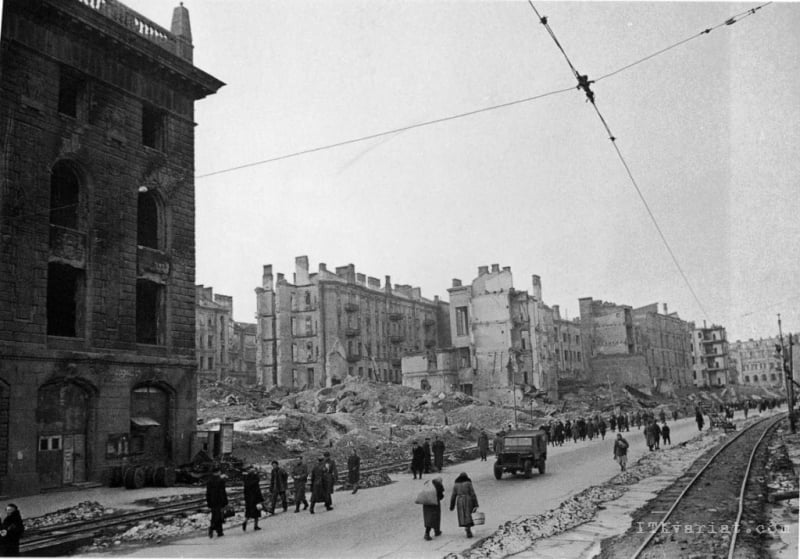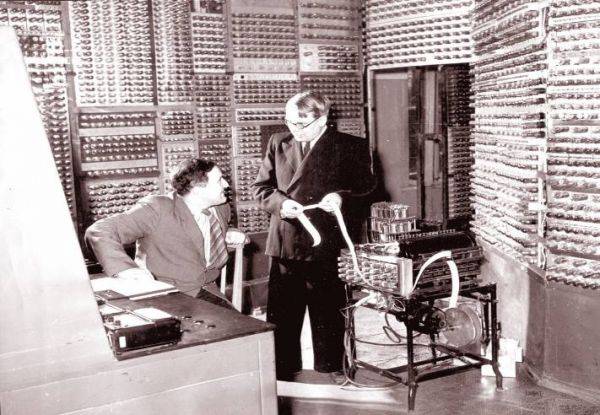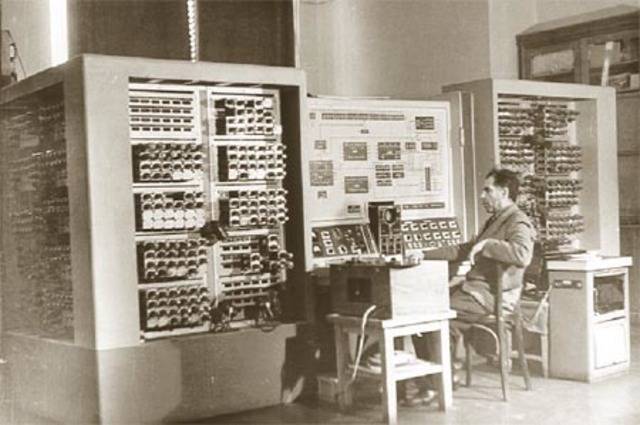Unique and forgotten: the birth of the Soviet missile defense system. Lebedev and MESM
MESM
It began in the Union immediately after the war (with a slight lag behind the United States and Great Britain, ahead of all other countries) independently in two places (Kiev and Moscow), with two people - Sergei Aleksandrovich Lebedev and Isaac Semenovich Brook (MESM and M-1 machines respectively).
MESM, like the British SSEM, was conceived as a model, therefore it was originally called the Model Electronic Counting Machine. But, unlike SSEM, the layout turned out to be quite workable. And the programs written for him, the first in Russian history, had practical significance almost from the very beginning. By the beginning of the development of the first Soviet computer, Lebedev was already a young, accomplished scientist. For a long time and successfully he was engaged in electrical engineering, in 1945 he was elected a full member of the Academy of Sciences of the Ukrainian SSR, in May 1946 he was appointed director of the Institute of Energy of the Academy of Sciences of the Ukrainian SSR in Kiev. In 1947, after the division of the institute, Lebedev became the director of the Institute of Electrical Engineering of the Academy of Sciences of the Ukrainian SSR and at the same time organized a laboratory of modeling and computer technology in it.
Just like his colleague Brooke, he receives the first information about the development of a fundamentally new class of computing technology - digital machines in a roundabout way from abroad. The chairman of the Academy of Sciences of the Ukrainian SSR from 1930 to 1946 (when he died of tuberculosis) was the famous Soviet biologist and pathophysiologist Alexander Aleksandrovich Bogomolets, who gathered around him a team of outstanding specialists in various fields of science, including mathematician Mikhail Alekseevich Lavrentiev, the future founder of the legendary Siberian branch of the Academy of Sciences of the USSR (in addition, it will still play a significant role in the development of early computers).
The son of A. A. Bogomolets, Oleg, also a biologist, was an inveterate radio amateur and, during his business trips to Switzerland, collected various magazines on electrical engineering and radio electronics. They included, among other things, descriptions of the work of the computer pioneer Dr. Konrad Ernst Otto Zuse, who developed the Z series for the ETH Zurich (the Z4, then under construction, became in 1950 the only working computer in continental Europe and the first computer in the world to was sold five months ahead of Mark I and ten months ahead of UNIVAC).
Returning to Kiev in the summer of 1948, OA Bogomolets shared these materials with Lavrentiev, the latter with Lebedev. And already in October 1948, the inspired Lebedev began to create MESM.
Despite the terrible conditions of post-war Ukraine, Lebedev's team, starting from scratch, managed two years later, on November 6, 1950, to carry out a test run (it took so much time for the car, among other things, because the MESM required more than 6000 lamps, and about a third of they were delivered from the factory defective). A year later, after successful testing by a commission of the USSR Academy of Sciences headed by Academician M.V. Keldysh, regular operation of the machine began.
Interestingly, the premises of the former monastery hostel in Feofaniya were so unsuitable for the operation of a huge lamp computer that part of the ceiling had to be demolished in the laboratory in order to remove the heat generated by thousands of lamps from the room. The conditions for creating MESM were hellish and not at all like the laboratories where ENIAC, Harvard Mk I and other computers were built in the United States.

Kiev after the war. The first creators of Soviet computers worked in such conditions (itkvariat.com)
MESM needed a room with an area of about 150 sq. m. and about the same - for generators, batteries and control automation. Plus workshops, worker dorms, and more. It was very difficult to find such a building in Kiev destroyed by the war. The building in Feofaniya was in disrepair, at first it had to be repaired. Every day a specially dedicated bus drove from Kiev to the developer's village, but at 17 o'clock he left back. People stayed at work for several days or even weeks.
Zinovy Lvovich Rabinovich, a student of Lebedev, recalls:
In addition, Lebedev faced another problem. His staff included Jews! Again, a word to Rabinovich:
As a result, in the fall of 1952, MESM performed calculations for the generators of the Kuibyshev hydroelectric power station. Learning that Feofania has a working computer, Kiev and Moscow mathematicians were drawn there with problems that required large-scale calculations. MESM worked round the clock counting thermonuclear reactions (Ya.B. Zel'dovich), ballistic missiles (M.V. Keldysh, A.A. Dorodnitsyn, A.A. Lyapunov), long-range transmission lines (S.A. Lebedev himself), statistical quality control (B.V. Gnedenko) and others. The first programmers in the USSR worked on this machine, including the famous mathematician MR Shura-Bura (he was "lucky" to work later with our first serial computer "Strela", and he spoke of it with horror, but we will tell about this later) ...

This is how it looked like working with MESM, note that the machine occupies all available wall surfaces, being simply mounted on them
Despite this, Lebedev did not receive any official honors (Rabinovich recalls):
MESM was used until 1957, until it was finally outdated, after which it was transferred to the KPI for educational purposes. In 1959, it was dismantled, the Ukrainian historian of computer technology Boris Nikolaevich Malinovsky recalled it this way:
Several electronic tubes and other components remaining from the MESM are kept in the Foundation for the History and Development of Computer Science and Technology at the Kiev House of Scientists of the National Academy of Sciences of Ukraine. However, a similar fate awaited ENIAC and, in general, practically all the first computers - neither in the Soviet Union, nor in the West, no one particularly bothered to create museums of computer technology. In the USSR, they did this with absolutely all computers - they dismantled both the Setun and all the first BESMs for scrap. Programmer of the first Soviet computers Alexander Konstantinovich Platonov, mathematician of the Institute of Applied Mathematics (an interview with him from 2017 was published on Habré) bitterly recalls:
SESM
Few people know that after Lebedev left for Moscow, his group, on the basis of his ideas, implemented (here already the general designer was the aforementioned Z. L. Rabinovich) an even more amazing idea - the so-called SESM, a Specialized Electronic Counting Machine. Its uniqueness lay in the fact that the SESM was a specialized computer, and a matrix-vector (!) One, one of the first, if not the first, in the world.
SESM was intended for solving correlation problems and systems of algebraic equations with 500 unknowns. The machine operated with fractions and had a current automatic control of the order of magnitude. The calculation results were given in the decimal system with an accuracy of the seventh digit. Based on the Gauss-Seidel LAU method adopted for SESM, the arithmetic device performed only addition and multiplication, but the computer turned out to be elegant - only 700 lamps.

Specialized electronic calculating machine "SESM", at the control panel S. B. Rozentsvaig (icfcst.kiev.ua)
Surprisingly, it was not classified. And it became the first Soviet computer to receive a laudatory review in the then-just appeared American computer magazine Datamation.
Moreover, a monograph written based on the results of the development ("Specialized electronic calculating machine SESM" Z. L. Rabinovich, Yu. V. Blagoveshchenskaya, R. A. Chernyak and others, Glushkov insisted on the publication of the book, the developers themselves were not particularly looking for fame, as a result he was right in securing our priority in this area) was reissued in the USA in English. And, apparently, was one of the first books on domestic computing, published abroad.
Zinovy Lvovich himself worked a lot and fruitfully in the field of computer science until the 1980s, together with such titans of world electronics as Academician V.M. Glushkov, including on air defense systems (it seems that in those years absolutely all computer Soviet specialists were involved in two areas: missile defense or air defense).
BESM
As we said, MESM was conceived by Lebedev as a prototype of a large machine (with an unpretentious name BESM), but it was unrealistic to implement a much more complex development in the dilapidated war of Feofania in Ukraine. And the designer decided to go to the capital. Let us again give the floor to Platonov (we will discuss ITMiVT and their relation to BESM in more detail below, there are many interesting things):
So Lebedev went to Moscow.
And there at that time for several years already a second group was working on their own, completely independent computer - under the leadership of Isaac Brook.
To be continued ...
Information